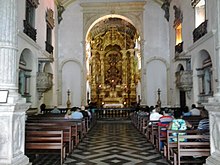Monastery Church of St. Benedict (Olinda)
The Monastery Church of St. Benedict ( Portuguese São Bento ) is the abbey church of the Benedictine Abbey of São Bento in Olinda , Pernambuco , Brazil . Dedicated to Benedict of Nursia , it is part of the São Bento Monastery, which is an important Baroque architectural complex. It is listed as a national cultural heritage and, along with a large part of the historic city center, has also been part of the UNESCO World Heritage since 1982 .
history
The founding of the São Bento monastery and the associated church go back to the Portuguese colonial times. The Benedictine order came to the Pernambuco captaincy in 1586 , today's state of the same name. First they used the small church of São João Batista dos Militares and were then taken to the small hermitage of Nossa Senhora do Monte, one of the oldest churches in Brazil. In 1597 the monks bought land and began building the monastery.
The first monastery was completed in 1599, but was soon destroyed when a fire caused by the Dutch invasion destroyed the city in 1631 . The monastery was soon rebuilt, reopened in 1656 and later expanded. Some interiors of the monastery are lined with precious furniture and impressive works of art, such as paintings of episodes from the life of St. Benedict, portraits of former abbots and masters of the country's Benedictine order.
church
The construction of today's St. Benedict Church began around 1660 after the fire in the old complex and was completed in 1761. The church was modeled after the Tibães monastery in Portugal , from which the Brazilian Benedictines come. The facade, designed by the master builder Francisco Nunes Soares, is a sober risalit . It has three carved wooden doors, shaped parts made of stones with loops. The central door is higher with a round window above it, and high rectangular ones above the side entrances. The volute gable shows the coat of arms of the Benedictine community of Valladolid, which was later also the coat of arms of the Benedictine community of Portugal, and which was also adopted by the Benedictine community of Brazil. There is a square bell tower on the right.
The most important part of the church furnishings is the magnificent, fully gilded high altar made of cedar wood, which was built between 1783 and 1786 and is one of the most beautiful and most important examples of gilded carvings in Brazil. In the middle is the image of St. Benedict, flanked by Gregory the Great and St. Scholastica . In 1860 it was revised with new gilding. 2001 was completely dismantled and restored by the Joaquim Nabuco Foundation. There was controversy in 2002 when it was on display in New York as the main attraction of the Brasil de Corpo e Alma exhibition at the Solomon R. Guggenheim Museum . The ceiling of the choir is adorned with a large painting depicting the death of the founder of the order, as shown in the second book of the dialogues of St. Gregory the Great emerges. There are three eighteenth-century silver lamps hanging from the same ceiling.
Just above a door on the left side of the transept there is a painting of the Italian school from the 14th century, showing Saint Sebastian , which was brought to the monastery at the end of the 19th century.
The nave has two pulpits and side altars with pictures from the 18th century. In the upper choir there is a life-size image of Christ crucified with an aura, surrounded by angels.
The sacristy is one of the richest in Olinda. It is equipped with furniture carved from cedar wood, decorated with crystal mirrors and wall panels. The ceiling shows the life of St. Benedict, works made by José Eloy da Conceição around 1785. In a large niche there is a large polychrome marble toilet made in Estremoz , Portugal. Other important pieces are a gold-framed altarpiece and a panel with Our Lady.
In 1998 the Church of St. Benedict was raised to the rank of a minor basilica by Pope John Paul II .
Web links
Individual evidence
- ↑ Historic Center of the Town of Olinda on unesco.org (English)
- ↑ Olinda - Igreja e Mosteiro de São Bento (Portuguese)
- ↑ Mosteiro de São Bento (1599) (Portuguese)
- ↑ São Bento on arquidioceseolindarecife.org (Portuguese)
- ↑ Spectabile quidem (Latin)
- ↑ Basílica Abacial do Mosteiro de São Bento de Olinda on gcatholic.org
Coordinates: 8 ° 1 ′ 11.8 ″ S , 34 ° 51 ′ 7.3 ″ W.

